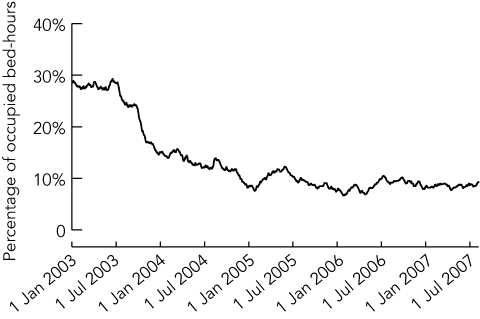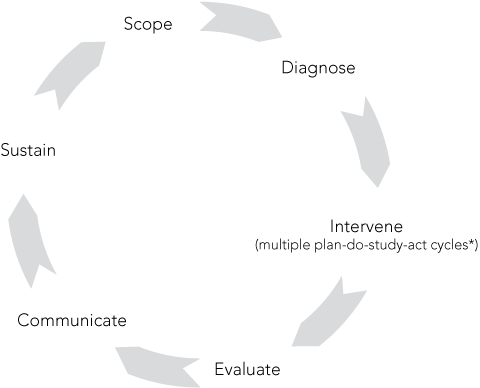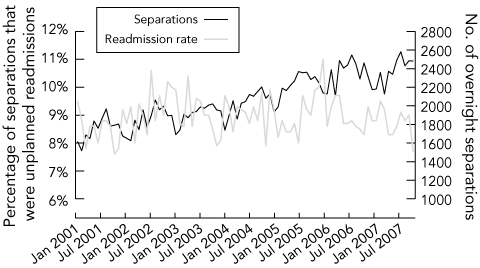In November 2003, the Flinders Medical Centre (FMC), a 500-bed teaching general hospital in the southern suburbs of Adelaide, initiated a program of clinical process redesign across the entire hospital. Redesigning Care, as the program is known, is based explicitly on applying an approach called “lean thinking”,1 which was developed in the manufacturing sector, to health care. The FMC provides the whole range of secondary and tertiary services required by its community, but its main focus is on providing time-urgent, complex care. The extensive nature of the Redesigning Care program, and its focus on a specific improvement method, may be of interest to those outside our centre. Redesigning Care can be considered in three broad phases: “getting the knowledge”, “stabilising high-volume flows”, and “standardising and sustaining”.
At this time, congestion in the ED had become so severe that the recovery area of the operating theatre suite had been taken over as an extension of the ED. There was bitter conflict between staff, key senior clinicians were prepared to leave, the “blame game” was pervasive, and surgical and medical programs were proving hard to sustain. An aggregated root-cause analysis of a series of deaths in the ED and elsewhere in the hospital made it clear that, despite having implemented a range of strategies to relieve congestion,2 the capacity to provide safe care was under threat.
As clinicians and senior managers, we were united in acknowledging that we needed to do something, but we did not yet know what or how. We were fortunate to obtain a key piece of advice from a member of the then United Kingdom National Health Service Modernisation Agency,3 who advised that sustainable change requires as much care in developing an improvement team, as in the improvement interventions themselves. Consequently, the Redesigning Care team — comprising three experienced clinicians designated as clinical facilitators, and a part-time director who was also a member of the hospital executive — was formed.
Lean thinking1 is an approach to the redesign of complex processes derived from methods developed in the manufacturing sector. Successful modern manufacturers, such as the Toyota Motor Corporation, are concerned with the timely, safe manufacture of a diverse range of cars or other goods, in large volume and at high quality. We also faced the challenges of volume, timeliness, diversity, and safety and quality, and after an early success with applying lean thinking, we elected to use it as the basis for our whole program of clinical process redesign. While lean thinking remains at the heart of the Redesigning Care program, over time we have borrowed from many other manufacturing philosophies.
As an improvement team, we needed to “get the technical knowledge” for redesign. Team members read the existing texts on lean thinking,1 and the team and hospital senior managers spent 2 days with a lean thinking expert from Lean Enterprise Australia. We also received generous support from the staff of the School of Management at the University of South Australia, where the team plus senior managers also participated in a Diploma in Lean Manufacturing. Through these contacts, we all came to appreciate the complexity of other service and manufacturing industries, and the seriousness with which quality control is approached outside health care.
Knowledge of lean thinking principles and practices helped us develop a new way of looking at our work, moving away from a craft-group skill base (eg, medical care, nursing) or a body system orientation (eg, cardiovascular, respiratory) towards a process view where the care is seen as the outcome of a sequential series of steps through a sectional and hierarchically organised institution or service (see illustration in "Patient journeys: the process of clinical redesign").4
Lean thinking principles need to be adapted to the specifics of health care,5 but adaptation is necessary for every setting in which lean thinking is applied, and the basics of process improvement are as appropriate for health care as they are for other service and manufacturing industries (Box 1).
From the outset, we realised that the Redesigning Care program was a change management process. Putting lean thinking into a broader change management context provided us with our overall redesign method (Box 2).
The facilitators then bring multidisciplinary groups of frontline staff together to diagnose process problems using mapping and staff “tag-alongs”, documenting actual practice (→ Patient journeys: the process of clinical redesign).4 Those same groups identify opportunities for redesign and make the necessary changes by means of a series of plan-do-study-act cycles6 (Box 2), each of which is evaluated according to relevant measures identified in the diagnostic phase. The key measurement issue is: how can we tell if what we have done has made things any better? As far as possible, the processes and outcomes measured need to be important to both the patients cared for by the institution and the practitioners. Separate measures may be required to capture these different concerns.
Early interventions at FMC streamed all ED patients into either a short-care (likely to be discharged) stream, or a longer-care (likely to be admitted) stream.7 This was followed by the development of a short-stay (less than 72 hours) medical/surgical emergency inpatient ward within the body of the hospital.8 Patients continue to be discharged in a timely manner from that ward no matter how congested the rest of the hospital becomes, thus aiding patient flows. Indeed, at times, up to a quarter of all adult inpatient emergency admissions are managed through this one ward of 26 beds.
These changes have gone hand-in-hand with a change to the bed management system. The change involved moving away from a central bed manager “pushing” patients into any available bed to instead functioning as a facilitator to help wards develop a structured process to “pull”. Thus, ward staff pull or find those patients from settings such as the acute medical assessment unit, the ED and high-dependency areas who best fit their ward care profiles, and move them expeditiously into their wards. The overall outcomes for the amount of time patients spent as “ward outliers” is shown in Box 3.
With a well conducted diagnostic phase and frontline participation, new ways to improve clinical processes readily emerge. Sustaining changes and making them “the way that is done around here” is a continual challenge. The key to this task seems to be creating standardised processes. This has always been challenging in health care where autonomy is held dear, but lean thinking is concerned with standardising processing sequences, not with changing the conduct of care itself. Once the best, most efficient and most effective way of undertaking a process has been developed and agreed on, it should become “standard work”.1 This standard work is developed and continually improved by the people who do the work. Examples from two different areas illustrate this process.
Hospitals, as workplaces, are often disorganised. People spend long periods of time just looking for things. Workplace organisation is a key feature of many lean thinking practices. It is reified under the rubric 5S (Sort, Set in order, Shine, Standardise and Sustain),9 which designates a set sequence of actions.
When the Redesigning Care program began in November 2003, the ED was struggling to cope with 140 patients arriving each day. The ED now routinely sees between 180 and 210 patients per day (an increase in demand of up to 50%) and manages them within the same physical space and with similar staff–patient ratios as previously. We have not had to resort to using the recovery area for overflow, and Box 4 and Box 5 show that overall processing outcomes have generally improved despite the increased numbers of arrivals. The small decrease in the percentage of patients in triage category 2 whose meaningful treatment was commenced within 10 minutes represents additional delays of 1 or 2 minutes, and has not been accompanied by any change in clinical outcomes.7 The number of patients leaving the ED without waiting to be treated declined sharply after the introduction of new processing sequences and improvements in aligning staff with those sequences, and has stayed low (Box 6). This is a concrete demonstration of patient satisfaction with the services provided.
Reassuringly, the number and types of serious adverse events throughout the hospital have declined strikingly since the beginning of the Redesigning Care program. In the financial year before the program began, the hospital made 91 notifications of serious medicolegal adverse events to its insurers. In the past financial year, the whole region, of which the hospital is the largest service, generated only 19 such referrals. This is despite the average overall numbers of emergency admissions increasing from 1200 per month at the onset of Redesigning Care, to over 1600 per month at present. (In Box 7, the increase in separations relates to the adult medical and surgical activity.)
Reassuringly, rates of unplanned readmissions to hospital have remained stable despite increased activity and decreased length of stay (Box 7).
1 Process redesign with the use of lean thinking
The basics of process improvement through lean thinking include:
being clear about what it is that you “make” at the step or stages in which you are involved
identifying who your customers are — who uses what you make, and what they value
identifying activity families or patient-care families and their value streams
improving flow
identifying and reducing waste
moving from “push” to “pull” processes
acknowledging that process improvement must be continuous
3 Percentage of medical and surgical inpatient bed-hours during which beds are occupied by “ward outliers”,* Flinders Medical Centre, 2003–2007
 | |||||||||||||||
4 Time spent in the emergency department for all patients, discharged patients and admitted patients, Flinders Medical Centre, 2002–2006
5 Percentages of all emergency department patients whose treatment was commenced in compliance with protocols for their triage categories, Flinders Medical Centre, 2002–2006
- 1. Womack J, Jones D. Lean thinking. Banish waste and create wealth in your corporation. London: Simon and Schuster, 1998.
- 2. Bartlett J, Cameron P, Cisera M. The Victorian emergency department collaboration. Int J Qual Health Care 2002; 14: 463-470.
- 3. UK National Health Service Modernisation Agency. Ten high impact changes for service improvement and delivery: a guide for NHS leaders. Leicester: NHS Modernisation Agency, 2004. http://www.ogc.gov.uk/documents/Health_High_Impact_Changes.pdf (accessed Jan 2008).
- 4. Ben-Tovim DI, Dougherty ML, O’Connell TJ, McGrath KM. Patient journeys: the process of clinical redesign. Med J Aust 2008; 188 (5 Suppl): S14-S17. <MJA full text>
- 5. Ben-Tovim DI, Bassham JE, Bolch D, et al. Lean thinking across a hospital: redesigning care at the Flinders Medical Centre. Aust Health Rev 2007; 31: 10-15.
- 6. Berwick DM. Developing and testing changes in delivery of care. Ann Intern Med 1998; 128: 651-656.
- 7. King DL, Ben-Tovim DI, Bassham J. Redesigning emergency department patient flows: application of Lean Thinking to health care. Emerg Med Australas 2006; 18: 391-397.
- 8. Cooke, M, Higgins J, Kidd P. Use of emergency and observation wards. A systematic literature review. Emerg Med J 2003; 20: 138-142.
- 9. Chapman CD. Clean house with lean 5S. Qual Prog 2005; 38: 27-32.








We thank the large number of staff at FMC who have participated in Redesigning Care activities; Lean Enterprise Australia for continuing support; and Professor John Marley for editorial advice. We also acknowledge the role of Dr Deborah Lloyd in editing this article and producing this supplement.
None identified.